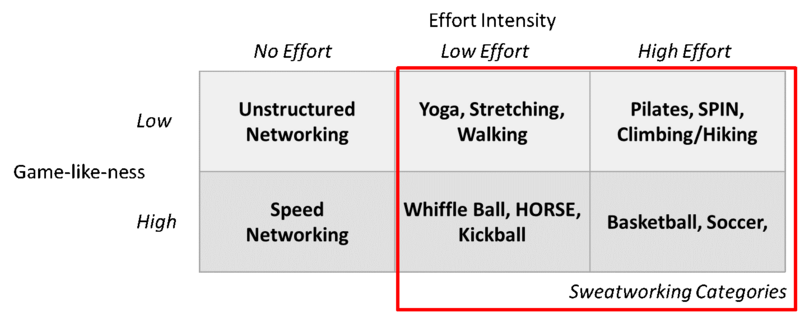ATD Blog
For Stronger Relationships With Your Colleagues and Customers, Put in Some Sweat Equity
Wed Feb 22 2017

Many employers stress the importance of networking to their employees. This is perhaps especially true for organizations that employ salespeople. However, while networking is an activity with potential long-term benefits, it also takes time away from activities that may produce more immediate results. In other words, when salespeople devote time to networking and relationship building, they do so at the expense of other professional, or even personal, pursuits.
So while salespeople struggle to meet performance expectations and find work-life balance, some organizations are encouraging them to try sweatworking (combining exercise with relationship-building activities) to perform these two activities that often go overlooked. Doing so allows individuals the opportunity to multitask in a healthy way. Given the rising costs of healthcare, organizations are taking fitness very seriously, working to cultivate wellness into company culture. For example, 17 percent of employers now offer on-site fitness, reports Ann Wyatt on benefitspro.com. Of course, what makes sweatworking most appealing isn’t just that it is a convenient way to streamline your schedule and stay healthy—it turns out that it is also an incredibly effective way to establish and grow business relationships.
Sweatworking can be done both internally (with other employees in your own company) and externally (with customers, prospects, and others).
Internal sweatworking provides colleagues an opportunity to participate in bonding activities that are outside the scope of their daily obligations. Many global brands now offer group runs, team sports, yoga sessions, and tennis matches during their annual sales meetings. Some progressive companies offer these activities even more frequently. These interactions facilitate employee connections in an environment that is aligned with the company’s culture. Given our emerging understanding of the importance of internal relationships in driving sales performance, the idea of sweatworking should not be overlooked.
External sweatworking, on the other hand, is replacing the happy hour schmoozing events with cardio and competition. Businesspeople are now choosing to connect with potential clients while also supporting an active lifestyle. It’s the next generation of deal making, with the potential to replace the golf course. Trade organizations like the Outdoor Industry Association and Grassroots Outdoor Alliance now host exercise opportunities during their conferences, including yoga classes, group hikes, and stand-up paddle board races.
How Does Sweatworking Work?
So what makes sweatworking such an effective relationship tool? Several psychological concepts shed light on the issue:
Psychology of Attribution: Exercise produces endorphins, which in turn produce positive mood and emotions. While it is the exercise that produces these effects, it is easy for individuals to begin to attribute these feelings to their sweatworking partner(s). It goes without saying that people are more likely to do business with those who make them feel good when they’re around!
Psychology of Framing: When a relationship is established on, or developed through, exercise and fitness activities, sweatworking partners implicitly begins to view each other through a lens that highlights advancement, improvement, and goal progress. Once this “frame” is established, it is natural for partners to apply these same concepts to each other in a business context.
Psychology of Gamification: Gamification applies lessons from gaming in nongame situations to improve motivation (because people are more willing to perform uncomfortable activities if they’re fun). Since many people are nervous about social situations, applying gaming elements like physical activity and competition encourages them to participate despite their hesitation.
Psychology of Vulnerability: Exercise subjects sweatworking partners to a surprising level of vulnerability. Vulnerability can occur because one partner doesn’t have the same strength or ability as their partner(s), or simply because sweating and panting reveals a very different side of a person than they might present in normal professional circumstances. Luckily, a glimpse of vulnerability can be very effective at deepening a relationship between sweatworking partners. People like to do business with people who are open and authentic.
What Should Managers Consider?
Managers should create sweatworking opportunities within and outside their firm. We suggest that managers consider the dispositions and current fitness level of employees when selecting sweatworking activities. The following figure makes recommendations for activities based on the effort intensity that the group is capable of, and how well they would respond to game-like elements in the activity.

